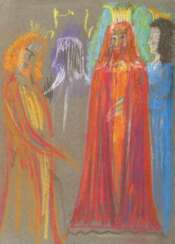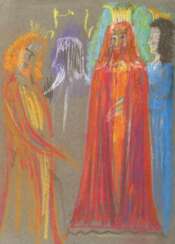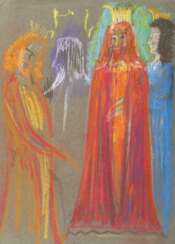Hans Poelzig (1869 - 1936) — Auction price

Hans Poelzig was a German architect, whose profound influence on art and culture was marked by his expressive and dramatic architectural style. His work, synonymous with the German Expressionist movement, forged a legacy of emotional and thought-provoking design that continues to resonate with art collectors and experts today.
Among Poelzig's most revered projects is the iconic I.G. Farben Building in Frankfurt, completed in 1931 and now part of Goethe University, a testament to his ability to design on a grand scale. His impact on architectural culture is also seen in the Grosses Schauspielhaus in Berlin, which stands as a paragon of expressionist architecture. This building, along with others like the Four Domes Pavilion in Wrocław, highlights Poelzig's penchant for theatrical and impactful design.
Poelzig's architectural narrative extended beyond the tangible; he conceptualized designs for the Palace of the Soviets and the League of Nations headquarters, which, despite remaining unbuilt, underscore the breadth of his vision. His academic roles, including director positions at the Breslau Art Academy and the Technical Academy in Berlin, allowed him to shape future architects and propagate his innovative design philosophy.
For those deeply invested in the realms of art and antiques, Poelzig’s creations are not merely structures but embodiments of a transformative era in architectural history. His buildings, some of which have earned the honor of being UNESCO World Heritage Sites, serve as a bridge between the past and present of architectural excellence.
To receive updates on new product sales and auction events related to Hans Poelzig, please sign up for our newsletter. This service is exclusively crafted for connoisseurs and professionals, offering timely information to enhance your collection and knowledge of historic art and architecture.


Hans Poelzig was a German architect, whose profound influence on art and culture was marked by his expressive and dramatic architectural style. His work, synonymous with the German Expressionist movement, forged a legacy of emotional and thought-provoking design that continues to resonate with art collectors and experts today.
Among Poelzig's most revered projects is the iconic I.G. Farben Building in Frankfurt, completed in 1931 and now part of Goethe University, a testament to his ability to design on a grand scale. His impact on architectural culture is also seen in the Grosses Schauspielhaus in Berlin, which stands as a paragon of expressionist architecture. This building, along with others like the Four Domes Pavilion in Wrocław, highlights Poelzig's penchant for theatrical and impactful design.
Poelzig's architectural narrative extended beyond the tangible; he conceptualized designs for the Palace of the Soviets and the League of Nations headquarters, which, despite remaining unbuilt, underscore the breadth of his vision. His academic roles, including director positions at the Breslau Art Academy and the Technical Academy in Berlin, allowed him to shape future architects and propagate his innovative design philosophy.
For those deeply invested in the realms of art and antiques, Poelzig’s creations are not merely structures but embodiments of a transformative era in architectural history. His buildings, some of which have earned the honor of being UNESCO World Heritage Sites, serve as a bridge between the past and present of architectural excellence.
To receive updates on new product sales and auction events related to Hans Poelzig, please sign up for our newsletter. This service is exclusively crafted for connoisseurs and professionals, offering timely information to enhance your collection and knowledge of historic art and architecture.


Hans Poelzig was a German architect, whose profound influence on art and culture was marked by his expressive and dramatic architectural style. His work, synonymous with the German Expressionist movement, forged a legacy of emotional and thought-provoking design that continues to resonate with art collectors and experts today.
Among Poelzig's most revered projects is the iconic I.G. Farben Building in Frankfurt, completed in 1931 and now part of Goethe University, a testament to his ability to design on a grand scale. His impact on architectural culture is also seen in the Grosses Schauspielhaus in Berlin, which stands as a paragon of expressionist architecture. This building, along with others like the Four Domes Pavilion in Wrocław, highlights Poelzig's penchant for theatrical and impactful design.
Poelzig's architectural narrative extended beyond the tangible; he conceptualized designs for the Palace of the Soviets and the League of Nations headquarters, which, despite remaining unbuilt, underscore the breadth of his vision. His academic roles, including director positions at the Breslau Art Academy and the Technical Academy in Berlin, allowed him to shape future architects and propagate his innovative design philosophy.
For those deeply invested in the realms of art and antiques, Poelzig’s creations are not merely structures but embodiments of a transformative era in architectural history. His buildings, some of which have earned the honor of being UNESCO World Heritage Sites, serve as a bridge between the past and present of architectural excellence.
To receive updates on new product sales and auction events related to Hans Poelzig, please sign up for our newsletter. This service is exclusively crafted for connoisseurs and professionals, offering timely information to enhance your collection and knowledge of historic art and architecture.


Hans Poelzig was a German architect, whose profound influence on art and culture was marked by his expressive and dramatic architectural style. His work, synonymous with the German Expressionist movement, forged a legacy of emotional and thought-provoking design that continues to resonate with art collectors and experts today.
Among Poelzig's most revered projects is the iconic I.G. Farben Building in Frankfurt, completed in 1931 and now part of Goethe University, a testament to his ability to design on a grand scale. His impact on architectural culture is also seen in the Grosses Schauspielhaus in Berlin, which stands as a paragon of expressionist architecture. This building, along with others like the Four Domes Pavilion in Wrocław, highlights Poelzig's penchant for theatrical and impactful design.
Poelzig's architectural narrative extended beyond the tangible; he conceptualized designs for the Palace of the Soviets and the League of Nations headquarters, which, despite remaining unbuilt, underscore the breadth of his vision. His academic roles, including director positions at the Breslau Art Academy and the Technical Academy in Berlin, allowed him to shape future architects and propagate his innovative design philosophy.
For those deeply invested in the realms of art and antiques, Poelzig’s creations are not merely structures but embodiments of a transformative era in architectural history. His buildings, some of which have earned the honor of being UNESCO World Heritage Sites, serve as a bridge between the past and present of architectural excellence.
To receive updates on new product sales and auction events related to Hans Poelzig, please sign up for our newsletter. This service is exclusively crafted for connoisseurs and professionals, offering timely information to enhance your collection and knowledge of historic art and architecture.


Hans Poelzig was a German architect, whose profound influence on art and culture was marked by his expressive and dramatic architectural style. His work, synonymous with the German Expressionist movement, forged a legacy of emotional and thought-provoking design that continues to resonate with art collectors and experts today.
Among Poelzig's most revered projects is the iconic I.G. Farben Building in Frankfurt, completed in 1931 and now part of Goethe University, a testament to his ability to design on a grand scale. His impact on architectural culture is also seen in the Grosses Schauspielhaus in Berlin, which stands as a paragon of expressionist architecture. This building, along with others like the Four Domes Pavilion in Wrocław, highlights Poelzig's penchant for theatrical and impactful design.
Poelzig's architectural narrative extended beyond the tangible; he conceptualized designs for the Palace of the Soviets and the League of Nations headquarters, which, despite remaining unbuilt, underscore the breadth of his vision. His academic roles, including director positions at the Breslau Art Academy and the Technical Academy in Berlin, allowed him to shape future architects and propagate his innovative design philosophy.
For those deeply invested in the realms of art and antiques, Poelzig’s creations are not merely structures but embodiments of a transformative era in architectural history. His buildings, some of which have earned the honor of being UNESCO World Heritage Sites, serve as a bridge between the past and present of architectural excellence.
To receive updates on new product sales and auction events related to Hans Poelzig, please sign up for our newsletter. This service is exclusively crafted for connoisseurs and professionals, offering timely information to enhance your collection and knowledge of historic art and architecture.


Hans Poelzig was a German architect, whose profound influence on art and culture was marked by his expressive and dramatic architectural style. His work, synonymous with the German Expressionist movement, forged a legacy of emotional and thought-provoking design that continues to resonate with art collectors and experts today.
Among Poelzig's most revered projects is the iconic I.G. Farben Building in Frankfurt, completed in 1931 and now part of Goethe University, a testament to his ability to design on a grand scale. His impact on architectural culture is also seen in the Grosses Schauspielhaus in Berlin, which stands as a paragon of expressionist architecture. This building, along with others like the Four Domes Pavilion in Wrocław, highlights Poelzig's penchant for theatrical and impactful design.
Poelzig's architectural narrative extended beyond the tangible; he conceptualized designs for the Palace of the Soviets and the League of Nations headquarters, which, despite remaining unbuilt, underscore the breadth of his vision. His academic roles, including director positions at the Breslau Art Academy and the Technical Academy in Berlin, allowed him to shape future architects and propagate his innovative design philosophy.
For those deeply invested in the realms of art and antiques, Poelzig’s creations are not merely structures but embodiments of a transformative era in architectural history. His buildings, some of which have earned the honor of being UNESCO World Heritage Sites, serve as a bridge between the past and present of architectural excellence.
To receive updates on new product sales and auction events related to Hans Poelzig, please sign up for our newsletter. This service is exclusively crafted for connoisseurs and professionals, offering timely information to enhance your collection and knowledge of historic art and architecture.


Hans Poelzig was a German architect, whose profound influence on art and culture was marked by his expressive and dramatic architectural style. His work, synonymous with the German Expressionist movement, forged a legacy of emotional and thought-provoking design that continues to resonate with art collectors and experts today.
Among Poelzig's most revered projects is the iconic I.G. Farben Building in Frankfurt, completed in 1931 and now part of Goethe University, a testament to his ability to design on a grand scale. His impact on architectural culture is also seen in the Grosses Schauspielhaus in Berlin, which stands as a paragon of expressionist architecture. This building, along with others like the Four Domes Pavilion in Wrocław, highlights Poelzig's penchant for theatrical and impactful design.
Poelzig's architectural narrative extended beyond the tangible; he conceptualized designs for the Palace of the Soviets and the League of Nations headquarters, which, despite remaining unbuilt, underscore the breadth of his vision. His academic roles, including director positions at the Breslau Art Academy and the Technical Academy in Berlin, allowed him to shape future architects and propagate his innovative design philosophy.
For those deeply invested in the realms of art and antiques, Poelzig’s creations are not merely structures but embodiments of a transformative era in architectural history. His buildings, some of which have earned the honor of being UNESCO World Heritage Sites, serve as a bridge between the past and present of architectural excellence.
To receive updates on new product sales and auction events related to Hans Poelzig, please sign up for our newsletter. This service is exclusively crafted for connoisseurs and professionals, offering timely information to enhance your collection and knowledge of historic art and architecture.


Hans Poelzig was a German architect, whose profound influence on art and culture was marked by his expressive and dramatic architectural style. His work, synonymous with the German Expressionist movement, forged a legacy of emotional and thought-provoking design that continues to resonate with art collectors and experts today.
Among Poelzig's most revered projects is the iconic I.G. Farben Building in Frankfurt, completed in 1931 and now part of Goethe University, a testament to his ability to design on a grand scale. His impact on architectural culture is also seen in the Grosses Schauspielhaus in Berlin, which stands as a paragon of expressionist architecture. This building, along with others like the Four Domes Pavilion in Wrocław, highlights Poelzig's penchant for theatrical and impactful design.
Poelzig's architectural narrative extended beyond the tangible; he conceptualized designs for the Palace of the Soviets and the League of Nations headquarters, which, despite remaining unbuilt, underscore the breadth of his vision. His academic roles, including director positions at the Breslau Art Academy and the Technical Academy in Berlin, allowed him to shape future architects and propagate his innovative design philosophy.
For those deeply invested in the realms of art and antiques, Poelzig’s creations are not merely structures but embodiments of a transformative era in architectural history. His buildings, some of which have earned the honor of being UNESCO World Heritage Sites, serve as a bridge between the past and present of architectural excellence.
To receive updates on new product sales and auction events related to Hans Poelzig, please sign up for our newsletter. This service is exclusively crafted for connoisseurs and professionals, offering timely information to enhance your collection and knowledge of historic art and architecture.


Hans Poelzig was a German architect, whose profound influence on art and culture was marked by his expressive and dramatic architectural style. His work, synonymous with the German Expressionist movement, forged a legacy of emotional and thought-provoking design that continues to resonate with art collectors and experts today.
Among Poelzig's most revered projects is the iconic I.G. Farben Building in Frankfurt, completed in 1931 and now part of Goethe University, a testament to his ability to design on a grand scale. His impact on architectural culture is also seen in the Grosses Schauspielhaus in Berlin, which stands as a paragon of expressionist architecture. This building, along with others like the Four Domes Pavilion in Wrocław, highlights Poelzig's penchant for theatrical and impactful design.
Poelzig's architectural narrative extended beyond the tangible; he conceptualized designs for the Palace of the Soviets and the League of Nations headquarters, which, despite remaining unbuilt, underscore the breadth of his vision. His academic roles, including director positions at the Breslau Art Academy and the Technical Academy in Berlin, allowed him to shape future architects and propagate his innovative design philosophy.
For those deeply invested in the realms of art and antiques, Poelzig’s creations are not merely structures but embodiments of a transformative era in architectural history. His buildings, some of which have earned the honor of being UNESCO World Heritage Sites, serve as a bridge between the past and present of architectural excellence.
To receive updates on new product sales and auction events related to Hans Poelzig, please sign up for our newsletter. This service is exclusively crafted for connoisseurs and professionals, offering timely information to enhance your collection and knowledge of historic art and architecture.


Hans Poelzig was a German architect, whose profound influence on art and culture was marked by his expressive and dramatic architectural style. His work, synonymous with the German Expressionist movement, forged a legacy of emotional and thought-provoking design that continues to resonate with art collectors and experts today.
Among Poelzig's most revered projects is the iconic I.G. Farben Building in Frankfurt, completed in 1931 and now part of Goethe University, a testament to his ability to design on a grand scale. His impact on architectural culture is also seen in the Grosses Schauspielhaus in Berlin, which stands as a paragon of expressionist architecture. This building, along with others like the Four Domes Pavilion in Wrocław, highlights Poelzig's penchant for theatrical and impactful design.
Poelzig's architectural narrative extended beyond the tangible; he conceptualized designs for the Palace of the Soviets and the League of Nations headquarters, which, despite remaining unbuilt, underscore the breadth of his vision. His academic roles, including director positions at the Breslau Art Academy and the Technical Academy in Berlin, allowed him to shape future architects and propagate his innovative design philosophy.
For those deeply invested in the realms of art and antiques, Poelzig’s creations are not merely structures but embodiments of a transformative era in architectural history. His buildings, some of which have earned the honor of being UNESCO World Heritage Sites, serve as a bridge between the past and present of architectural excellence.
To receive updates on new product sales and auction events related to Hans Poelzig, please sign up for our newsletter. This service is exclusively crafted for connoisseurs and professionals, offering timely information to enhance your collection and knowledge of historic art and architecture.


Hans Poelzig was a German architect, whose profound influence on art and culture was marked by his expressive and dramatic architectural style. His work, synonymous with the German Expressionist movement, forged a legacy of emotional and thought-provoking design that continues to resonate with art collectors and experts today.
Among Poelzig's most revered projects is the iconic I.G. Farben Building in Frankfurt, completed in 1931 and now part of Goethe University, a testament to his ability to design on a grand scale. His impact on architectural culture is also seen in the Grosses Schauspielhaus in Berlin, which stands as a paragon of expressionist architecture. This building, along with others like the Four Domes Pavilion in Wrocław, highlights Poelzig's penchant for theatrical and impactful design.
Poelzig's architectural narrative extended beyond the tangible; he conceptualized designs for the Palace of the Soviets and the League of Nations headquarters, which, despite remaining unbuilt, underscore the breadth of his vision. His academic roles, including director positions at the Breslau Art Academy and the Technical Academy in Berlin, allowed him to shape future architects and propagate his innovative design philosophy.
For those deeply invested in the realms of art and antiques, Poelzig’s creations are not merely structures but embodiments of a transformative era in architectural history. His buildings, some of which have earned the honor of being UNESCO World Heritage Sites, serve as a bridge between the past and present of architectural excellence.
To receive updates on new product sales and auction events related to Hans Poelzig, please sign up for our newsletter. This service is exclusively crafted for connoisseurs and professionals, offering timely information to enhance your collection and knowledge of historic art and architecture.


Hans Poelzig was a German architect, whose profound influence on art and culture was marked by his expressive and dramatic architectural style. His work, synonymous with the German Expressionist movement, forged a legacy of emotional and thought-provoking design that continues to resonate with art collectors and experts today.
Among Poelzig's most revered projects is the iconic I.G. Farben Building in Frankfurt, completed in 1931 and now part of Goethe University, a testament to his ability to design on a grand scale. His impact on architectural culture is also seen in the Grosses Schauspielhaus in Berlin, which stands as a paragon of expressionist architecture. This building, along with others like the Four Domes Pavilion in Wrocław, highlights Poelzig's penchant for theatrical and impactful design.
Poelzig's architectural narrative extended beyond the tangible; he conceptualized designs for the Palace of the Soviets and the League of Nations headquarters, which, despite remaining unbuilt, underscore the breadth of his vision. His academic roles, including director positions at the Breslau Art Academy and the Technical Academy in Berlin, allowed him to shape future architects and propagate his innovative design philosophy.
For those deeply invested in the realms of art and antiques, Poelzig’s creations are not merely structures but embodiments of a transformative era in architectural history. His buildings, some of which have earned the honor of being UNESCO World Heritage Sites, serve as a bridge between the past and present of architectural excellence.
To receive updates on new product sales and auction events related to Hans Poelzig, please sign up for our newsletter. This service is exclusively crafted for connoisseurs and professionals, offering timely information to enhance your collection and knowledge of historic art and architecture.


Hans Poelzig was a German architect, whose profound influence on art and culture was marked by his expressive and dramatic architectural style. His work, synonymous with the German Expressionist movement, forged a legacy of emotional and thought-provoking design that continues to resonate with art collectors and experts today.
Among Poelzig's most revered projects is the iconic I.G. Farben Building in Frankfurt, completed in 1931 and now part of Goethe University, a testament to his ability to design on a grand scale. His impact on architectural culture is also seen in the Grosses Schauspielhaus in Berlin, which stands as a paragon of expressionist architecture. This building, along with others like the Four Domes Pavilion in Wrocław, highlights Poelzig's penchant for theatrical and impactful design.
Poelzig's architectural narrative extended beyond the tangible; he conceptualized designs for the Palace of the Soviets and the League of Nations headquarters, which, despite remaining unbuilt, underscore the breadth of his vision. His academic roles, including director positions at the Breslau Art Academy and the Technical Academy in Berlin, allowed him to shape future architects and propagate his innovative design philosophy.
For those deeply invested in the realms of art and antiques, Poelzig’s creations are not merely structures but embodiments of a transformative era in architectural history. His buildings, some of which have earned the honor of being UNESCO World Heritage Sites, serve as a bridge between the past and present of architectural excellence.
To receive updates on new product sales and auction events related to Hans Poelzig, please sign up for our newsletter. This service is exclusively crafted for connoisseurs and professionals, offering timely information to enhance your collection and knowledge of historic art and architecture.


Hans Poelzig was a German architect, whose profound influence on art and culture was marked by his expressive and dramatic architectural style. His work, synonymous with the German Expressionist movement, forged a legacy of emotional and thought-provoking design that continues to resonate with art collectors and experts today.
Among Poelzig's most revered projects is the iconic I.G. Farben Building in Frankfurt, completed in 1931 and now part of Goethe University, a testament to his ability to design on a grand scale. His impact on architectural culture is also seen in the Grosses Schauspielhaus in Berlin, which stands as a paragon of expressionist architecture. This building, along with others like the Four Domes Pavilion in Wrocław, highlights Poelzig's penchant for theatrical and impactful design.
Poelzig's architectural narrative extended beyond the tangible; he conceptualized designs for the Palace of the Soviets and the League of Nations headquarters, which, despite remaining unbuilt, underscore the breadth of his vision. His academic roles, including director positions at the Breslau Art Academy and the Technical Academy in Berlin, allowed him to shape future architects and propagate his innovative design philosophy.
For those deeply invested in the realms of art and antiques, Poelzig’s creations are not merely structures but embodiments of a transformative era in architectural history. His buildings, some of which have earned the honor of being UNESCO World Heritage Sites, serve as a bridge between the past and present of architectural excellence.
To receive updates on new product sales and auction events related to Hans Poelzig, please sign up for our newsletter. This service is exclusively crafted for connoisseurs and professionals, offering timely information to enhance your collection and knowledge of historic art and architecture.


Hans Poelzig was a German architect, whose profound influence on art and culture was marked by his expressive and dramatic architectural style. His work, synonymous with the German Expressionist movement, forged a legacy of emotional and thought-provoking design that continues to resonate with art collectors and experts today.
Among Poelzig's most revered projects is the iconic I.G. Farben Building in Frankfurt, completed in 1931 and now part of Goethe University, a testament to his ability to design on a grand scale. His impact on architectural culture is also seen in the Grosses Schauspielhaus in Berlin, which stands as a paragon of expressionist architecture. This building, along with others like the Four Domes Pavilion in Wrocław, highlights Poelzig's penchant for theatrical and impactful design.
Poelzig's architectural narrative extended beyond the tangible; he conceptualized designs for the Palace of the Soviets and the League of Nations headquarters, which, despite remaining unbuilt, underscore the breadth of his vision. His academic roles, including director positions at the Breslau Art Academy and the Technical Academy in Berlin, allowed him to shape future architects and propagate his innovative design philosophy.
For those deeply invested in the realms of art and antiques, Poelzig’s creations are not merely structures but embodiments of a transformative era in architectural history. His buildings, some of which have earned the honor of being UNESCO World Heritage Sites, serve as a bridge between the past and present of architectural excellence.
To receive updates on new product sales and auction events related to Hans Poelzig, please sign up for our newsletter. This service is exclusively crafted for connoisseurs and professionals, offering timely information to enhance your collection and knowledge of historic art and architecture.


Hans Poelzig was a German architect, whose profound influence on art and culture was marked by his expressive and dramatic architectural style. His work, synonymous with the German Expressionist movement, forged a legacy of emotional and thought-provoking design that continues to resonate with art collectors and experts today.
Among Poelzig's most revered projects is the iconic I.G. Farben Building in Frankfurt, completed in 1931 and now part of Goethe University, a testament to his ability to design on a grand scale. His impact on architectural culture is also seen in the Grosses Schauspielhaus in Berlin, which stands as a paragon of expressionist architecture. This building, along with others like the Four Domes Pavilion in Wrocław, highlights Poelzig's penchant for theatrical and impactful design.
Poelzig's architectural narrative extended beyond the tangible; he conceptualized designs for the Palace of the Soviets and the League of Nations headquarters, which, despite remaining unbuilt, underscore the breadth of his vision. His academic roles, including director positions at the Breslau Art Academy and the Technical Academy in Berlin, allowed him to shape future architects and propagate his innovative design philosophy.
For those deeply invested in the realms of art and antiques, Poelzig’s creations are not merely structures but embodiments of a transformative era in architectural history. His buildings, some of which have earned the honor of being UNESCO World Heritage Sites, serve as a bridge between the past and present of architectural excellence.
To receive updates on new product sales and auction events related to Hans Poelzig, please sign up for our newsletter. This service is exclusively crafted for connoisseurs and professionals, offering timely information to enhance your collection and knowledge of historic art and architecture.


Hans Poelzig was a German architect, whose profound influence on art and culture was marked by his expressive and dramatic architectural style. His work, synonymous with the German Expressionist movement, forged a legacy of emotional and thought-provoking design that continues to resonate with art collectors and experts today.
Among Poelzig's most revered projects is the iconic I.G. Farben Building in Frankfurt, completed in 1931 and now part of Goethe University, a testament to his ability to design on a grand scale. His impact on architectural culture is also seen in the Grosses Schauspielhaus in Berlin, which stands as a paragon of expressionist architecture. This building, along with others like the Four Domes Pavilion in Wrocław, highlights Poelzig's penchant for theatrical and impactful design.
Poelzig's architectural narrative extended beyond the tangible; he conceptualized designs for the Palace of the Soviets and the League of Nations headquarters, which, despite remaining unbuilt, underscore the breadth of his vision. His academic roles, including director positions at the Breslau Art Academy and the Technical Academy in Berlin, allowed him to shape future architects and propagate his innovative design philosophy.
For those deeply invested in the realms of art and antiques, Poelzig’s creations are not merely structures but embodiments of a transformative era in architectural history. His buildings, some of which have earned the honor of being UNESCO World Heritage Sites, serve as a bridge between the past and present of architectural excellence.
To receive updates on new product sales and auction events related to Hans Poelzig, please sign up for our newsletter. This service is exclusively crafted for connoisseurs and professionals, offering timely information to enhance your collection and knowledge of historic art and architecture.


Hans Poelzig was a German architect, whose profound influence on art and culture was marked by his expressive and dramatic architectural style. His work, synonymous with the German Expressionist movement, forged a legacy of emotional and thought-provoking design that continues to resonate with art collectors and experts today.
Among Poelzig's most revered projects is the iconic I.G. Farben Building in Frankfurt, completed in 1931 and now part of Goethe University, a testament to his ability to design on a grand scale. His impact on architectural culture is also seen in the Grosses Schauspielhaus in Berlin, which stands as a paragon of expressionist architecture. This building, along with others like the Four Domes Pavilion in Wrocław, highlights Poelzig's penchant for theatrical and impactful design.
Poelzig's architectural narrative extended beyond the tangible; he conceptualized designs for the Palace of the Soviets and the League of Nations headquarters, which, despite remaining unbuilt, underscore the breadth of his vision. His academic roles, including director positions at the Breslau Art Academy and the Technical Academy in Berlin, allowed him to shape future architects and propagate his innovative design philosophy.
For those deeply invested in the realms of art and antiques, Poelzig’s creations are not merely structures but embodiments of a transformative era in architectural history. His buildings, some of which have earned the honor of being UNESCO World Heritage Sites, serve as a bridge between the past and present of architectural excellence.
To receive updates on new product sales and auction events related to Hans Poelzig, please sign up for our newsletter. This service is exclusively crafted for connoisseurs and professionals, offering timely information to enhance your collection and knowledge of historic art and architecture.


Hans Poelzig was a German architect, whose profound influence on art and culture was marked by his expressive and dramatic architectural style. His work, synonymous with the German Expressionist movement, forged a legacy of emotional and thought-provoking design that continues to resonate with art collectors and experts today.
Among Poelzig's most revered projects is the iconic I.G. Farben Building in Frankfurt, completed in 1931 and now part of Goethe University, a testament to his ability to design on a grand scale. His impact on architectural culture is also seen in the Grosses Schauspielhaus in Berlin, which stands as a paragon of expressionist architecture. This building, along with others like the Four Domes Pavilion in Wrocław, highlights Poelzig's penchant for theatrical and impactful design.
Poelzig's architectural narrative extended beyond the tangible; he conceptualized designs for the Palace of the Soviets and the League of Nations headquarters, which, despite remaining unbuilt, underscore the breadth of his vision. His academic roles, including director positions at the Breslau Art Academy and the Technical Academy in Berlin, allowed him to shape future architects and propagate his innovative design philosophy.
For those deeply invested in the realms of art and antiques, Poelzig’s creations are not merely structures but embodiments of a transformative era in architectural history. His buildings, some of which have earned the honor of being UNESCO World Heritage Sites, serve as a bridge between the past and present of architectural excellence.
To receive updates on new product sales and auction events related to Hans Poelzig, please sign up for our newsletter. This service is exclusively crafted for connoisseurs and professionals, offering timely information to enhance your collection and knowledge of historic art and architecture.


Hans Poelzig was a German architect, whose profound influence on art and culture was marked by his expressive and dramatic architectural style. His work, synonymous with the German Expressionist movement, forged a legacy of emotional and thought-provoking design that continues to resonate with art collectors and experts today.
Among Poelzig's most revered projects is the iconic I.G. Farben Building in Frankfurt, completed in 1931 and now part of Goethe University, a testament to his ability to design on a grand scale. His impact on architectural culture is also seen in the Grosses Schauspielhaus in Berlin, which stands as a paragon of expressionist architecture. This building, along with others like the Four Domes Pavilion in Wrocław, highlights Poelzig's penchant for theatrical and impactful design.
Poelzig's architectural narrative extended beyond the tangible; he conceptualized designs for the Palace of the Soviets and the League of Nations headquarters, which, despite remaining unbuilt, underscore the breadth of his vision. His academic roles, including director positions at the Breslau Art Academy and the Technical Academy in Berlin, allowed him to shape future architects and propagate his innovative design philosophy.
For those deeply invested in the realms of art and antiques, Poelzig’s creations are not merely structures but embodiments of a transformative era in architectural history. His buildings, some of which have earned the honor of being UNESCO World Heritage Sites, serve as a bridge between the past and present of architectural excellence.
To receive updates on new product sales and auction events related to Hans Poelzig, please sign up for our newsletter. This service is exclusively crafted for connoisseurs and professionals, offering timely information to enhance your collection and knowledge of historic art and architecture.








































